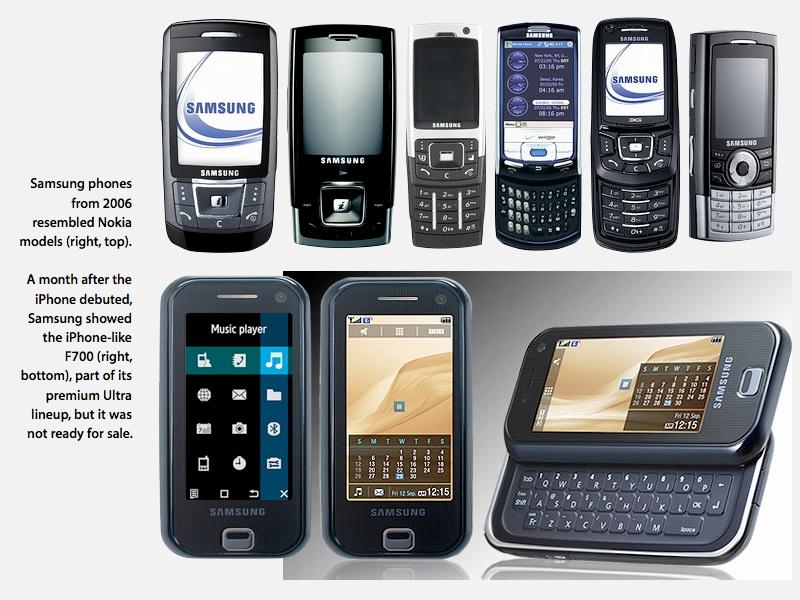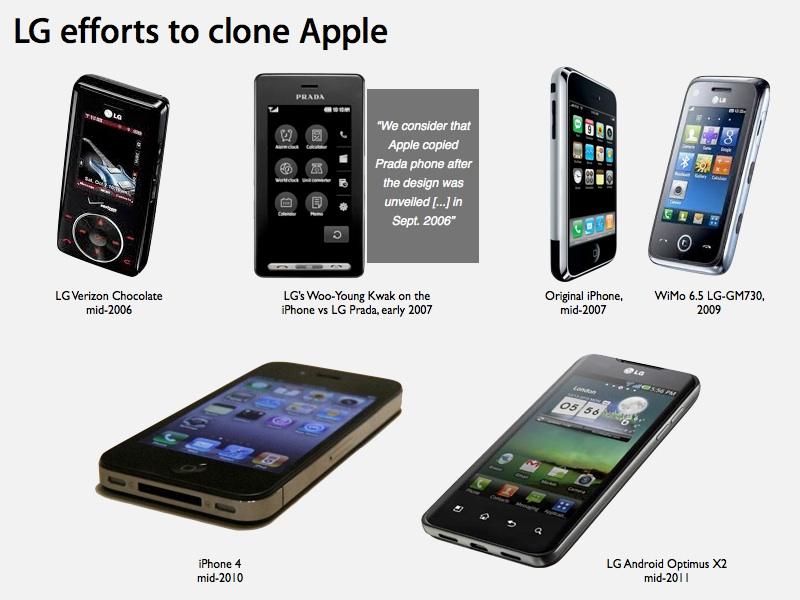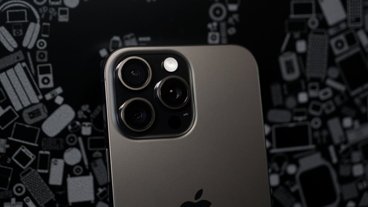The claim, distributed virally on message boards in the form of a graphic comparing the 2007 iPhone against the Samsung F700, is titled "LOL @ Apple: suing someone you stole the design from to being [sic] with," and portrays an early Samsung phone with a black front, rounded corners and grid of icons, all elements of the complaint by Apple which claims infringement upon its iPhone design by various Samsung products.
The graphic states the Samsung F700 was first shown at CEBIT in 2006, and was released in February 2007, while noting that the iPhone was first shown at Macworld in January 2007 and didn't go on sale until the end of June 2007.
However, the graphic is in error, as Samsung only mentioned plans for the new phone in 2006. It wasn't actually shown until February 2007 at the 3GSM World Congress, held a month after the iPhone's debut. It did not go on sale at that time.
What Samsung actually did
When Apple unveiled the original iPhone in January 2007, Samsung was actually selling a variety of smartphones that looked more like Nokia devices, with a four direction rocker navigation button, six or more buttons for handing calling features, and in most cases, a traditional set of physical number dialing buttons.
The F700 was rushed out to show after the iPhone's debut, and was regarded as an "answer to the iPhone" by reports of the day, one of which observed that it "looks awfully familiar."
However, the F700 also carried a number of notable features that Apple didn't offer until later, including support for 7.2Mbps HSDPA mobile networks (not available until the iPhone 3GS) and a 5 megapixel camera (unmatched until iPhone 4). If anything, it indicates that Apple faced serious technical hurdles in entering the mobile business in competition with much more experienced mobile manufacturers.
What Apple brought to the mobile business wasn't a copy of existing technology, but breakthroughs in original design aimed at usability, with features such as a truly useful mobile browser, tight integration with iPod and iTunes media sync, and a novel app model.
With its Galaxy line of mobile products, Samsung has copied not just the overall look of the iPhone, iPad and iPod touch, but went even further to add a "Touchwiz" layer to Android that makes its devices far more closely resemble Apple's products than other Android licensee have.
After the release of iPad 2, Samsung even publicly admitted needing to redesign its Galaxy Tab to more closely resemble Apple's product.
It was LG, not Samsung, who complained
After the iPhone's debut, it was LG, not Samsung, that complained Apple had copied its design. LG had actually demonstrated its own full-screen smartphone in the fall of 2006, and like the iPhone, it had a largely black, minimalist front. It was first to market with a capacitive touchscreen, the same type subsequently used by the iPhone.
Unlike the iPhone, LG's Prada phone built its user interface using Adobe Flash Lite, with a home screen featuring six round, monochrome icons and a separate menu bar. The phone was intended to sell through Prada stores, at $775.
After Apple unveiled the iPhone, LG's Woo-Young Kwak, who headed its Mobile Handset R&D Center, called a press conference and stated, "we consider that Apple copied the Prada phone after the design was unveiled when it was presented in the iF Design Award and won the prize in September 2006."
The company didn't file a lawsuit however. LG had already shown an affinity for Apple's designs, changing its LG Chocolate phone for the US market to resemble a classic iPod.
Two years later, LG delivered its GM730 phone running Windows Mobile 6.5, with a grid of colored icons above a home row of shortcuts, and rounded corners tipping a hat to the original iPhone. This year, the company is producing an Android-based Optimus X2, which appears closely pattered after last year's iPhone 4.
 Daniel Eran Dilger
Daniel Eran Dilger









-m.jpg)






 Charles Martin
Charles Martin
 Marko Zivkovic
Marko Zivkovic
 Andrew Orr
Andrew Orr
 Amber Neely
Amber Neely

 William Gallagher and Mike Wuerthele
William Gallagher and Mike Wuerthele










304 Comments
Funny. I think you spend more time on Android sites than you do apple. I really think deep down inside DED, you love android.
Its fairly amazing the revisionist history being undertaken by Google and the Fandroids. I get a laugh out of these people saying Apple copied them when you can look at preliminary Android UI and hardware designs and see that Blackberry and Nokia were the intended copy victims. After Apple revealed their first iPhone, then Android quickly morphed into something else. Samsung obviously copied Apple. I reckon it will be up to a judge and jury to decide if and to what extent Samsung is liable for their infringements. I think it should be intuitively obvious to the most casual observer, but IANAL.
I'm pretty sure that if Samsung had stuck with the F700 interface, Apple wouldn't be suing them
Funny. I think you spend more time on Android sites than you do apple. I really think deep down inside DED, you love android.
He loves the industry and facts, so yes, he reads a lot.
Oh but what about the Google antitrust that's going on in the EU right now? Surely they can do no evil.